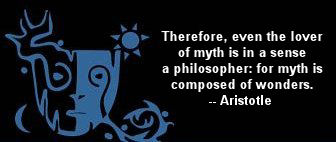|

A Worldchanging Imagination
by William G. Doty
[Images: "Mayflower Landing" lithograph; "Along the Hudson" by John Fredrick Kensett; "The Last Whole Earth Catalog"]
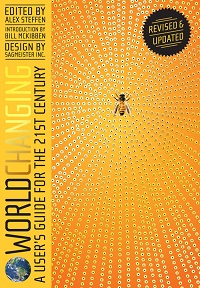 With respect to the monthly theme of Mythic Passages for September, "Schooling the Imagination," I'd like to suggest that so far as I am concerned, "to learn" is "to imagine." Whether toward the future — the usual direction toward which the imagination is thought to be directed — or turned toward the past, of which we have always only records of how distant presents were imaged/imagined after their times. Whatever direction attention is aimed, learning ought to be conceived as disciplining, deciding which organizations, which interpretive filters allow the past — history, etymologically, what some learned person has inquired into — to be charted. With respect to the monthly theme of Mythic Passages for September, "Schooling the Imagination," I'd like to suggest that so far as I am concerned, "to learn" is "to imagine." Whether toward the future — the usual direction toward which the imagination is thought to be directed — or turned toward the past, of which we have always only records of how distant presents were imaged/imagined after their times. Whatever direction attention is aimed, learning ought to be conceived as disciplining, deciding which organizations, which interpretive filters allow the past — history, etymologically, what some learned person has inquired into — to be charted.
Simon Danser remarks "In contrast to politically-promoted views of the past, history is not directly dependent on what really happened in the past but on how it is remembered or, more pedantically, how it is repeatedly recreated in the present. [A]ttempts to filter the past into specific historic narratives are no more than ideological myths" (44). So history is an imagination that creates a coherent narrative about a possible past, based upon some tangible records or inferences from possible consequences of recorded actions.
Such imaginings (I do not mean fantasies, but "constructed results extrapolated from what seem most-likely happenings") provide viewpoints (worldviews) according to which certain events and perspectives appear meaningful and are sufficiently muscular and intelligent to project future-possibles (I call this learning imaginal athletics). Through such perspectives we decide how to culture politically those that, on the basis of our evaluation of past experiences, seem most likely to grow eu- rather than dys-trophies; positive/healthy communities rather than disasters.
Ecological/environmental issues belatedly surfaced into mass consciousness in the 1960s, and then environmentalism became the politically-active, forward-looking choice. However, human attitudes toward the Terran oikos (household, ecology) have always shaped success as well as failure to adjust the coexistence of the human biosphere and the sheer physical thereness of the environment. Religious and mythological perspectives have often shaped the alignment as oppositional, culture vs. nature, human vs. animal. Where the choices are less dichotomies than coequal pairs — as in much of Eastern philosophy, teachers stress the continuities of life forces.
We have fewer future educators active today than in the last half-century or so — among them the years of sterling environmental education supported by Senator Al Gore, who certainly has earned international renown for his dedicated advocacy for the survival of the planet. Names I pointed out in July's column (Leopold, Abbey, Carson, Commoner, Ehrlich, Naess, Reich, Schumacher, Udall, and others) brought awareness of the earth alongside the spacey philosophical-religious focus upon the non-embodied mind/logos/spirit of most academic theology and philosophy that has often seemed ashamed that the carnal or fleshly should structure our mortal frames.
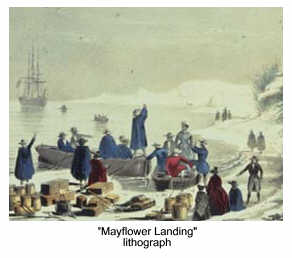 As I pointed out last month, works such as Nash's Wilderness and the American Mind and others sensitize us to the fact that the pioneers saw, as they stepped off the Mayflower, a "hideous and desolate wilderness" (William Bradford; 24 ... with "hellish fiends, and brutish men" — Michael Wigglesworth, 36) which might well be the work of the Devil and could only face extermination or conquest. Michigan Territory residents were horrified that Tocqueville would set out to travel for pleasure in the primaeval forest (23). Biblical references to the exodus through the wilderness were used to justify turning the "useless lands" into farms and pastures; settlers saw themselves as the agents of God breaking down the power of evil (36). As I pointed out last month, works such as Nash's Wilderness and the American Mind and others sensitize us to the fact that the pioneers saw, as they stepped off the Mayflower, a "hideous and desolate wilderness" (William Bradford; 24 ... with "hellish fiends, and brutish men" — Michael Wigglesworth, 36) which might well be the work of the Devil and could only face extermination or conquest. Michigan Territory residents were horrified that Tocqueville would set out to travel for pleasure in the primaeval forest (23). Biblical references to the exodus through the wilderness were used to justify turning the "useless lands" into farms and pastures; settlers saw themselves as the agents of God breaking down the power of evil (36).
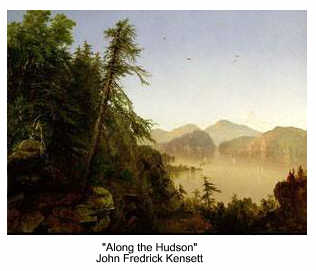 Only in Romantic thought was nature conceived of as benign — as shown for instance in the Hudson River School of painting or the paintings that represented the far West — wilderness as (positively) awesome and somehow a source of solace. Nonetheless, even into the mid twentieth century, wilderness was still regarded as the enemy, so that President Johnson's signing of the 1964 National Wilderness Preservation System bill was a great victory for the Land. More recently the Bush administration has done all in its power to reverse such preservation to please its forestry and petroleum cronies. Only in Romantic thought was nature conceived of as benign — as shown for instance in the Hudson River School of painting or the paintings that represented the far West — wilderness as (positively) awesome and somehow a source of solace. Nonetheless, even into the mid twentieth century, wilderness was still regarded as the enemy, so that President Johnson's signing of the 1964 National Wilderness Preservation System bill was a great victory for the Land. More recently the Bush administration has done all in its power to reverse such preservation to please its forestry and petroleum cronies.
There are many other ways psychological perceptions have changed or need to, more than I can treat here. But let me point to a few works by James Hillman (see the Works Cited, with brief annotations): his work has important implications for the traditional distinction between the isolated self and the soul of the world (anima mundae), between the natural and the fabricated, between the animal and the human.
Today, perhaps, the single most proactive teachers are to be found in the various Green-oriented movements (particularly in Europe; see the excellent and comprehensive bird's-eye collection edited by Andrew Dobson, The Green Reader). And above all there is the book, Worldchanging (a massive account of what is already being usefully imagined in our own age, and in many cases realized) part of an ongoing international project. The book only indexes some of the energies displayed on the website Worldchanging.com.
While our household has for decades wrangled with supermarket helpers who insist upon putting our plastic-wrapped purchases into yet additional plastic (read: petrochemically-produced) bags, instead of the reusable canvas bags we bring and ask them to use. We have followed hundreds of suggested lists of how to save on consumption of natural resources, and Worldchanging is without equal in portraying how much an ethically-charged future imagination can do in our immediate households, neighborhoods, local communities, and internationally.
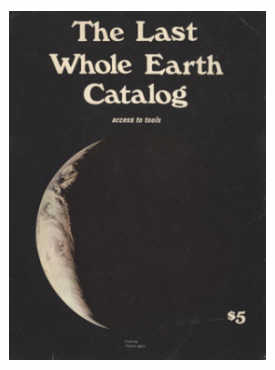 Various editions of Whole Earth Catalogs published twice a year between 1968 and 1972, and then occasionally until 1998, certainly taught several generations how to select ecologically-sound products and choices, and now this user's guide comes on board to help us imagine — and live accordingly — new ways of moving beyong Agribiz, Big Pharma, and Plastic, if we are to avoid exhausting the natural resources of this Green Planet. In his foreword, Gore reminds us (teaches us) of the need for strong moral leadership and generational responsibility in meeting our "climate crisis of great magnitude" (11) Various editions of Whole Earth Catalogs published twice a year between 1968 and 1972, and then occasionally until 1998, certainly taught several generations how to select ecologically-sound products and choices, and now this user's guide comes on board to help us imagine — and live accordingly — new ways of moving beyong Agribiz, Big Pharma, and Plastic, if we are to avoid exhausting the natural resources of this Green Planet. In his foreword, Gore reminds us (teaches us) of the need for strong moral leadership and generational responsibility in meeting our "climate crisis of great magnitude" (11)
Imagine a Sixth Extinction of animate life, caused not by meteor impact or ice age, but by greed and overuse of resources and overpopulation. Steffen recaps in his introduction what ought to be statistical scares familiar to each of us every day: global population has mushroomed from 2.5 billion people to over 6 billion in just the last five decades; even the best scenario indicates 8 billion 45 years from now which is like adding a city larger than Seattle every week, every year, for the next 50 years (16-17, 489, 491).
With respect to filling that huge SUV gasoline tank: "Oil company experts debate whether we will effectively run out of oil in twenty years or fifty, but the essential point remains: if you're under thirty, you can expect to see a post-oil civilization in your lifetime" (17). And generally with respect to the hemorrhaging of our natural capital, "Most everyone studying the issue seems to agree that if we haven't made deep and profound changes to our impact on the planet by 2050, we'll have committed our civilization to a series of catastrophes" (17).
But I do not want to repeat the doom-and-gloom scenarios we have heard repeatedly in my generation. Instead I want to highlight both the now self-evident fact that "we need to consciously redesign the entire material basis of our civilization" (21), and to stress that Worldchanging documents a vast array of ways in which we can anticipate and support ecologically-proactive movements that are less utopian/fantasyland than down-to-the-nitty-gritty realistic and do-able.
Some examples: reclaimed flooring used in Green remodeling (142); windmill-generated electricity could supply as much as a third of current needs, economically (175). There are neobiological developments such as hacked bacterias that can produce methane fuel from garbage (110); algae that can produce hydrogen fuel (111); fungi that can remediate polluted soil (250); and marshes that can purify sewage (195).
"Small is beautiful" was E. F. Schumacher's slogan, which in its original context seemed anti-modern and trivializing, but I see now how extraordinarily important it is that "small" must be imagined in our day. I cannot any longer brook chemically dredged vegetable and fruits that have so much less flavor than what we receive from our Farmers' Market and Community Sponsored Agriculture Co-ops. One learns quickly enough that artificially produced asparagus, tomatoes, and corn on the cob available in January cannot hold a candle to real spring and summer produce.
Some cities operate shops where seldom-used but advanced tools can be checked out or provide workshop areas that can be shared (268). Others provide computers essential to support of community development (296), and even promote socially-responsible investing (352).
Here I've been able only to skim portions of a very important book, and I might easily have included Senator Gore's books and the DVD version of Inconvenient Truth. After nearly fifty years of teaching at the university level, I am willing to say, quite honestly, that Worldchanging may be as important as Gilgamesh was in shaping an attitude toward nature. I'm always embarrassed by the fact that our earliest recorded Western myth has its two heroes celebrate their union by cutting down an entire forest of trees (reminiscent of the famous Cedars of Lebanon); and by the dogma proclaimed in Genesis that the role of humankind is to rule and dominate the creation.
Perhaps, then, the book is a new, much-needed basis for mythically dwelling on this planet.
Works Cited
- Danser, Simon. 2005. The Myths of Reality. Wymeswold GB: Alternative Albion-Heart of Albion. (Available from albion@indigogroup.co.uk.)
- Dobson, Andrew, ed. 1991. The Green Reader: Essays Toward a Sustainable Society. San Francisco: Mercury House.
- Gore, Albert. 1992. Earth in the Balance: Ecology and the Human Spirit. Boston: Houghton Mifflin.
- Gore, Albert. 2006. Inconvenient Truth: The Planetary Emergence of Global Warming and What We Can Do About It. Emmaus PA: Rodale.
- Hillman, James. 1979 [1976]. "Peaks and Vales: The Soul/Spirit Distinction as Basis for the Differences Between Psychotherapy and Spiritual Discipline." On the Way to Self-Knowledge. Ed. J. Needleman and D. Lewis. New York: Knopf; 114-47. Repr. in Puer Papers. Dallas: Spring; 54-74. A major exploration of the danger of dichotomous definitions such as nature vs. spirit, the higher spiritual vs. the lower material, etc.
- Hillman, James. 1985. "Natural Beauty Without Nature." Spring 1985: 50-55. Expanded version in P. A. Y. Gunter and B. Higgins, eds. LandMark Program. Dallas: Landmark Program, 1984. Unpacks a traditional supposition by suggesting that "The natural is not necessarily the beautiful and the beautiful not necessarily natural. [....I]magination is perpetually creating nature and recreating it in a new guise" (51).
- Hillman, James. 1990. "On Mythical Certitude." Sphinx: A Journal for Archetypal Psychology and the Arts 3:224-43. Especially in this context, 233, where Hillman emphasizes the importance of the embodied mind that is ultimately part of a sort of world soul.
- Hillman, James. 1992. "A Psyche the Size of the Earth: A Psychological Foreword." Theodore Roszak, Mary E. Gomes, and Allen D. Kanner, eds. Ecopsychology: Restoring the Earth, Healing the Mind; xvii-xxiii. Explores new ways of opening the "I" to the "other" of the world as we re-place the subject back into the world.
- Schumacher, E. F. 1989 [1973]. Small is Beautiful: Economics As If People Mattered. New York: Harper and Row.
- Steffen, Alex, ed. 2006. Worldchanging: A User's Guide for the 21st Century. New York: Abrams-La Martinière Groupe.
William Doty, Ph.D. is Professor Emeritus of Humanities and Religious Studies at the University of Alabama and former editor of Mythosphere: A Journal for Image, Mythi, and Symbol (Vol. 1 Issue 1) . Dr. Doty is a prolific writer, translator, and editor who has published more than twenty books and seventy essays in a wide range of journals on topics including religious studies, anthropology, psychology, classics, and art criticism. His best known books include Mythography: The Study of Myths and Rituals . Dr. Doty is a prolific writer, translator, and editor who has published more than twenty books and seventy essays in a wide range of journals on topics including religious studies, anthropology, psychology, classics, and art criticism. His best known books include Mythography: The Study of Myths and Rituals , Myths of Masculinity , Myths of Masculinity , and Myth: A Handbook , and Myth: A Handbook . .
Read more articles in this series by Dr. Doty
Return to Passages Menu
Subscribe to the Passages e-zine
|
